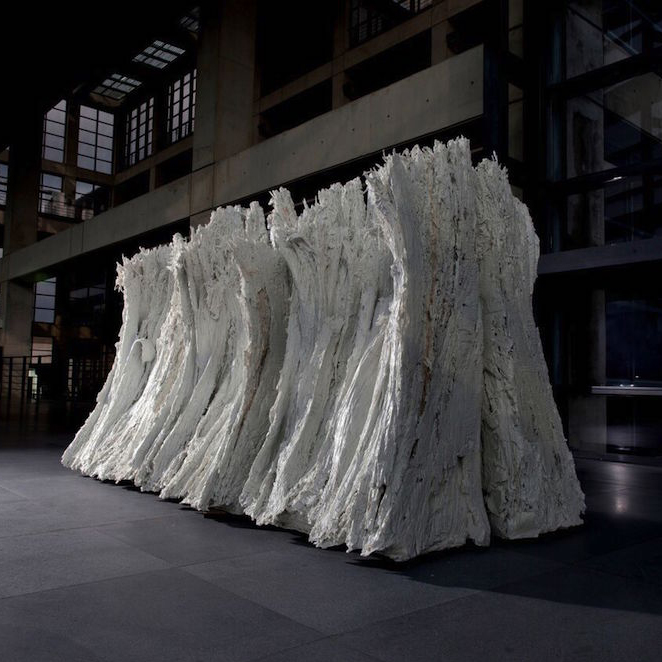Imagine watching time pass rapidly inside a micro-environment where you can decide when to stop and observe or to continue on. You could stop near the beginning where nearly no change has taken place, or wait so long that the observed world you originally knew had eroded away, burned, cracked, melted, and crumbled. Somewhere in the process is a place that tells a story of both the past and the future, about the range of elemental properties, and about mortality. Brad Even Taylor strives to freeze this powerful moment in his monumental sculptures by watching his work through an eyeball-size peephole, working in tandem with the pyroclastic nature of ceramic.
Taylor received his MFA from Alfred University in 1992 where he explored the phenomenology of ceramic, determining the ideal firing temperature for his work based on its cracking, slumping, and dripping in the kiln. Currently, Taylor is Associate Professor of Art at the University of Hawaii at Manoa in Honolulu. His 2015 solo exhibition titled Rift at the New Taipei City Yingge Ceramics Museum featured towering porcelain forms about metamorphosis.
From Taylor’s statement:
“I test matter, and choose the most eloquent of translucent whites. I challenge my strength with the resistance of my materials – pushing us both to our physical limits. I explore the potentials of clay; and I choreograph the movement of mass – fire collaborates; but I control and limit its input.”
At first glance Taylor’s work looks like actual geological forms excavated and moved into a new space. It’s always surprising to see such huge chunks of rock out of context, like Levitated Mass by Michael Heizer at LACMA, because you can’t help but imagine the process of it arriving there. Either the building was constructed around it or it was a part of some elaborate relocation maneuver.
The linear arrangements, gently floating displays and repeated forms in Rift are just slightly too specific to be serendipity; they’re created with direction and intention by Taylor. The artist, a mere human, created something magnificent that also looks effortless. These are god-like capabilities that empower the viewer with a bizarre sense of Zen megalomania.
Grandeur and glory are not what inspire the work’s size though, he is interested in viewers experiencing the work on a real-world scale. Small-scale art objects are perceived through a lens of “this needs to be looked at” where environmental-scale work allows the experience to directly and simply feel the effect of it.
Taylor quotes Rothko in his essay Environment, Art, Ceramics, and Site Specificity to describe the effect of environment, dealing with art or otherwise:
“Mark Rothko writes of body-scale to art-scale, environment, and surroundings, and their impact on art experience this way, “I paint very large pictures. I realize that historically the function of painting large pictures is painting something very grandiose and pompous. The reason I paint them…is precisely because I want to be very intimate and human. To paint a small picture is to place yourself outside your experience, to look upon an experience as a stereopticon view with a reducing glass. However you paint the larger pictures, you are in it. It isn’t something you command.”
Taylor is a phenomenologist. He works in collaboration with the material, guiding the ceramic but, encouraging its freedom in each step of the process. There is very little about the work in Rift that feels like an uncompromising decision by Taylor. Even the hovering effect of the masses, one of the few unbroken consistencies, is a suggestion to the form, not a command, a nice surprise revealed when you look underneath.
Taylor mentions in his statement that he considers the work finished at many stages throughout the process, but makes a point to recognize “a state that demands to be left.” Even after Taylors decision to stop, his sculptures continue to change over time through altered environment. This is an appropriate evolution that adds to each work’s history, creating a fresh iteration even when seeing the same piece multiple times. The work’s continued and recorded changes give life to the cold geological sculptures, begging for an empathy not allowed to static objects. His massive sculptures unexpectedly share a crucial part of the human experience, showing pain in the rips and cracks, pleasure in the smooth vitreous surfaces, they mimic figure in their form, and share an incredibly erotic physicality with us.
Everything about Taylor’s sculptures is profound: their mass, the process, the tension in the cracks, the large gestural forms, their size, and their endless ghostly white color. The work seems too impressive for a single human to accomplish, and so it stands still and glorious like the Rothko Chapel, creating a truly spiritual, borderline religious, art experience.
Justin Crowe is a Writer and Director of Operations at CFile.
Any thoughts about this post? Share yours in the comment box below.




























Wonderful work ! Such a feeling of Tactile Motion. Very inspirational.